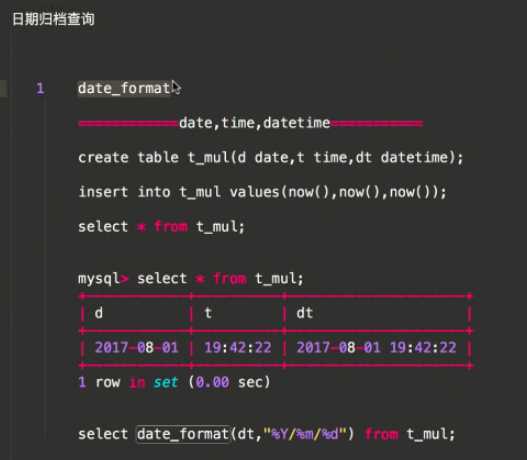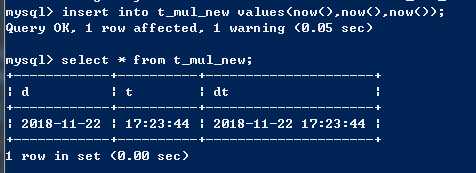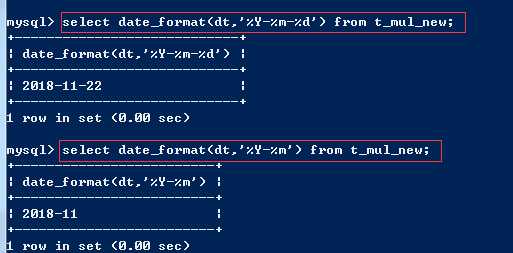标签:display creat 数据库 有一个 信息 ref 关系 tle orm

查询: 日期归档查询 1 date_format ============date,time,datetime=========== create table t_mul_new(d date,t time,dt datetime); insert into t_mul_new values(now(),now(),now()); select * from t_mul; mysql> select * from t_mul; +------------+----------+---------------------+ | d | t | dt | +------------+----------+---------------------+ | 2017-08-01 | 19:42:22 | 2017-08-01 19:42:22 | +------------+----------+---------------------+ 1 row in set (0.00 sec) select date_format(dt,"%Y/%m/%d") from t_mul; 2 extra extra(select=None, where=None, params=None, tables=None, order_by=None, select_params=None) 有些情况下,Django的查询语法难以简单的表达复杂的 WHERE 子句,对于这种情况, Django 提供了 extra() QuerySet修改机制 — 它能在 QuerySet生成的SQL从句中注入新子句 extra可以指定一个或多个 参数,例如 select, where or tables. 这些参数都不是必须的,但是你至少要使用一个!要注意这些额外的方式对不同的数据库引擎可能存在移植性问题.(因为你在显式的书写SQL语句),除非万不得已,尽量避免这样做 参数之select The select 参数可以让你在 SELECT 从句中添加其他字段信息,它应该是一个字典,存放着属性名到 SQL 从句的映射。 queryResult=models.Article .objects.extra(select={‘is_recent‘: "create_time > ‘2017-09-05‘"}) 结果集中每个 Entry 对象都有一个额外的属性is_recent, 它是一个布尔值,表示 Article对象的create_time 是否晚于2017-09-05. 练习: in sqlite: article_obj=models.Article.objects .extra(select={"standard_time":"strftime(‘%%Y-%%m-%%d‘,create_time)"}) .values("standard_time","nid","title") print(article_obj) # <QuerySet [{‘title‘: ‘MongoDb 入门教程‘, ‘standard_time‘: ‘2017-09-03‘, ‘nid‘: 1}]> 3 单表分组查询 ...... 4 日期归档查询的方式2 from django.db.models.functions import TruncMonth Sales.objects .annotate(month=TruncMonth(‘timestamp‘)) # Truncate to month and add to select list .values(‘month‘) # Group By month .annotate(c=Count(‘id‘)) # Select the count of the grouping .values(‘month‘, ‘c‘) # (might be redundant, haven‘t tested) select month and count

# 个人站点页面设计 re_path(r‘^(?P<username>\w+)$‘, views.home_site, name=‘home_site‘),

not_found.html

<!DOCTYPE html> <html lang="en"> <head> <meta charset="UTF-8"> <title>Title</title> <link rel="stylesheet" href="/static/blog/bootstrap-3.3.7/css/bootstrap.css"> </head> <body> <div class="container" style="margin-top: 100px"> <div class="text-center"> <a href="http://www.cnblogs.com/"><img src="/static/img/logo_small.gif" alt="cnblogs"></a> <p><b>404.</b> 抱歉! 您访问的资源不存在!</p> <p class="d">请确认您输入的网址是否正确,如果问题持续存在,请发邮件至 404042726@qq.com 与 <strong style="font-size: 28px">老村长</strong> 联系。</p> <p><a href="/">返回网站首页</a></p> </div> </div> </body> </html>

(2)查询当前站点对应的所有文章
def home_site(request,username): ‘‘‘ 个人站点视图函数 :param request: :return: ‘‘‘ user=UserInfo.objects.filter(username=username).first() # 判断用户是否存在 if not user: return render(request,‘not_found.html‘) # 当前用户或者当前站点所对应文章 blog=user.blog
print(blog)
# 方式一基于对象查询 # 作者和文章的关系---> 一对多(文章) article_list=user.article_set.all() # 方式二 基于双下划线 __ 跨表查询 article_list=models.Article.objects.filter(user=user) return render(request, ‘home_site.html‘)
# 跨表的分组查询的模型: # 每一个后的表模型.objects.values("pk").annotate(聚合函数(关联表__统计字段)).values("表模型的所有字段以及统计字段") # 推荐pk字段查找 # 查询每一个分类名称以及对应的文章数 # 查询当前站点的每一个分类名称以及对应的文章数 # 查询当前站点的每一个标签名称以及对应的文章数 # 查询当前站点每一个年月的名称以及对应的文章数
from django.db.models import Avg, Max, Min, Sum, Count
# 补充知识点Emp.objects.all()-----select * from emp # 补充知识点Emp.objects.all().values(‘name‘)-----select name from emp
# values(‘province‘)---values(‘group by的字段‘)

values方法可以获取字段的字典列表。
values_list可以获取字段的元组列表。

# 查询每一个分类名称以及对应的文章数 # annotate(聚合函数(关联表__统计字段)).values("表模型的所有字段以及统计字段") # values(‘group by的字段‘) ret=models.Category.objects.values(‘pk‘).annotate(c=Count(‘article__title‘)).values(‘title‘,‘c‘) print(ret)
# 查询当前站点的每一个分类名称以及对应的文章数 cate_list=models.Category.objects.filter(blog=blog).values(‘pk‘).annotate(c=Count(‘article__title‘)).values(‘title‘,‘c‘) print(cate_list)
# 每一个标签以及对应得文章数 tag_list=models.Tag.objects.filter(blog=blog).values(‘pk‘).annotate(count=Count(‘article‘)).values_list(‘title‘,‘count‘) print(‘tag_list‘,tag_list)

create table t_mul_new(d date,t time,dt datetime);
insert into t_mul_new values(now(),now(),now()); select * from t_mul_new;


---

标签:display creat 数据库 有一个 信息 ref 关系 tle orm
原文地址:https://www.cnblogs.com/foremostxl/p/10002478.html